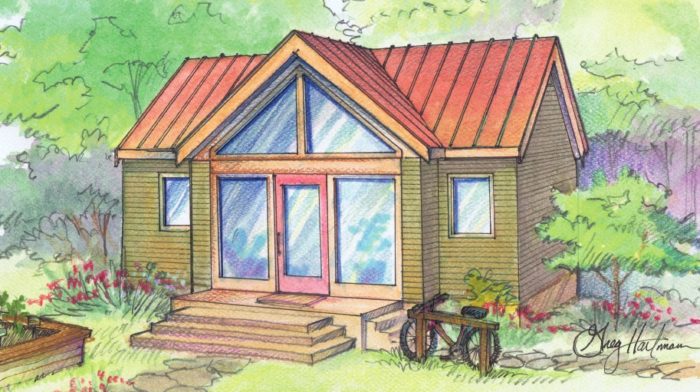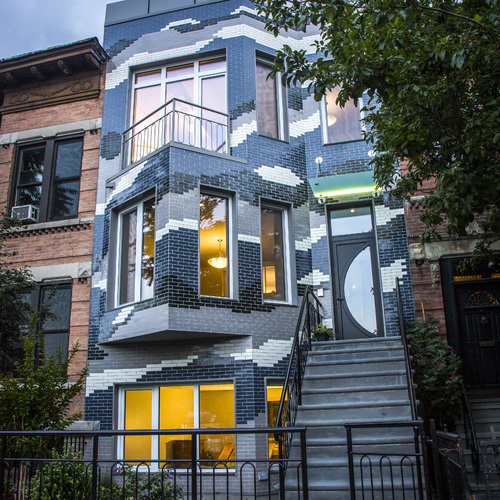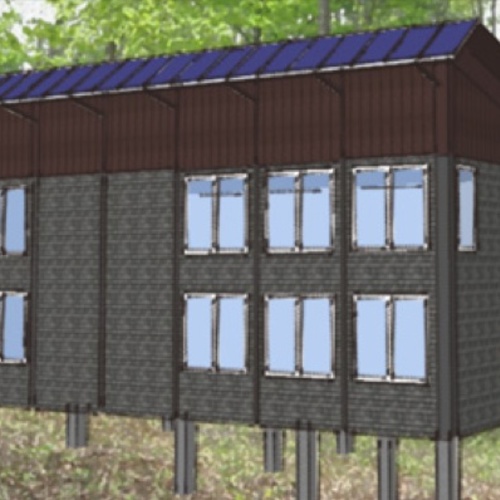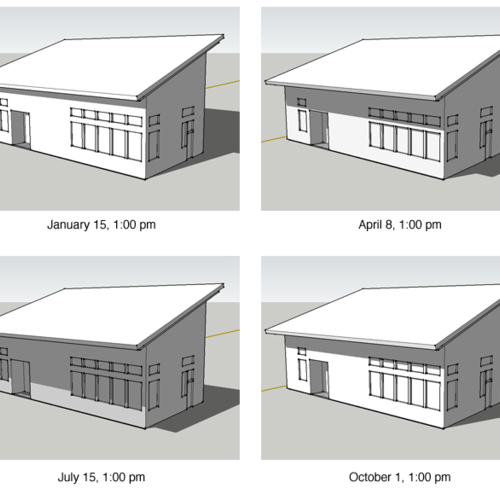Image Credit: Mini-B Passive House / Johnson Braund Design Group
Image Credit: Mini-B Passive House / Johnson Braund Design Group The Mini-B’s exterior-wall sheathing was sealed with a liquid-applied WRB marketed under the R-Guard brand. R-Guard also sells companion products to seal windows. When GBA senior editor Martin Holladay visited Seattle in March 2011, he visited the Mini-B Passihaus and took this photo of Joe Giampietro in the miniature home's living room..
Image Credit: Martin Holladay
UPDATED 3/22/2011: New photo added.
It looks like a Solar Decathlon entry, only smaller. At about 300 sq. ft., much smaller, actually. But the Mini-B Passive House, as its creators call it, is designed to pack big performance in a small package.
The product of collaboration between Joe Giampietro, a certified Passive House consultant and architect with Johnson Braund Design Group in Seattle, and instructors and students at Seattle Central Community College’s Wood Construction Center, Mini-B is designed and built to Passive House performance standards, and also conforms to Seattle’s code requirements for backyard cottages (known to the city’s Department of Planning and Development as “detached accessory dwelling units”).
Mini-B’s grand opening is scheduled for January 15 at a community center, the Phinney Neighborhood Association, after final work on the exterior and interior is completed. The house will be displayed at the community center for six months, and then will be sold for between $70,000 and $80,000. Giampietro told GBA that the plan is to eventually build more Mini-Bs (and perhaps some to a larger scale) in concert with a modular-home builder, if customer demand warrants it. The house also can be site-built. But the primary goal at this point, he said, is to highlight the benefits of Passive House construction.
Small, but still airtight
Framing started in March, and by mid-June the house was ready for a blower-door test, during which it yielded about 0.40 air changes per hour at a pressure difference of 50 Pascals, well within the Passive House 0.60 ach limit. Giampietro said the wall and roof construction includes conventional 2×4 framing with half-inch plywood sheathing that was treated with a system of R-Guard liquid-membrane sealing products. R-Guard materials also served as the window wrap and window caulking. The R-Guard sealers, Giampietro added, worked extremely well in assuring the fully assembled enclosure’s airtightness.
A 9-in. blanket of expanded polystyrene was applied over the sheathing and secured with adhesive and 1×4 cedar furring, through which 12-in. structural-insulated-panel screws were used to sandwich the assembly together. The exterior is covered with extra-wide James Hardie lap siding. The resulting thermal resistance is calculated to be R-52.4 for the walls, R-52.2 for the roof, and R-75.5 for the floor, where the space between its 2×10 joists is filled solid with insulation. The floor is topped with 1.5 in. of exposed concrete.
The feasibility of actual Passive House certification for the prototype, Giampietro noted, will depend on how and where the house is sited once it finds a buyer. We’ll add photos of the completed building once they become available.
Weekly Newsletter
Get building science and energy efficiency advice, plus special offers, in your inbox.
















4 Comments
Penetration details
Does Johnson Braund have any information on the details around window and door penetrations?
Penetration Details
JBDG response to Steve_OH: The windows and door for the mini-B were set into boxed openings made up of 1x12 pine which allows the window to sit out into the EPS insulation layer surrounding the structure. The windows, high performance from Serious, are sealed at the interior side with a caulk joint providing a complete seal from the window to the weather resistive barrier that wraps into the window opening. If you have further questions, please contact me through the website http://www.minibpassivehouse.com. JG
Student-built “Mini-B” Passive House on display Jan. 15, 2011
WHAT:
Come explore and tour the 300-square foot eco-friendly, energy efficient, and green living modular residence also known as the “Mini-B”. The home was built by 22 carpentry students at Seattle Central Community College/Wood Construction Center under the supervision of instructor Frank Mestemacher.
WHEN:
Saturday, January 15, 2011
10 am – 1:30 pm
WHERE:
Phinney Neighborhood Association Center
6532 Phinney Ave North
Lower parking lot off North 67th Street
Seattle WA 98103
Representatives from Seattle Central’s Wood Construction Center, Johnson Braund Design Group, Phinney Neighborhood Association and the Northwest EcoBuilding Guild will be available for interviews in advance or at the open house.
BACKGROUND:
The home will be on display at the center for six months. During that time the Seattle chapter of the Northwest EcoBuilding Guild will be using the Mini-B to encourage building practices that promote super energy efficiency. After its six-month stay at the center the Mini-B will go on sale with more planned to be built and sold.
Students built the Mini-B from start to finish applying the principles of airtight construction and high-performance in all phases of the home’s construction:
• Placing high-performance windows appropriately for solar gain
• Installing insulation and air barrier that is almost 100 percent air-tight, with full-time 100% fresh air ventilation
• Utilizing building methods and materials to allow for passive solar heating
• Completing all the interior details
The Mini-B, designed by architect Joe Giampietro (Johnson Braund Design Group), has a kitchenette, three-quarters bath, living/dining room, bed loft, closet, equipment loft with storage, solar hot water collector, and vaulted ceiling. It is built to an energy conservation standard that uses approximately 15 percent of the heating energy used by similar houses built to current Washington State Energy Code requirements. Once the last inspection and test is completed, Mini-B will be certified as a “Passive House” by the Passive House Institute U.S.
FOR FURTHER INFORMATION:
Frank Mestemacher – Seattle Central carpentry instructor, 206.516.2970 or [email protected]
Joe Giampietro – Mini-B building designer and architect, 206.766.8300 or [email protected]
Media Contact:
Judy Kitzman
Communications Specialist
Seattle Central Community College
206.587.5487, [email protected]
We want one!
TIme to retire, plan on a house behind our daughter, on a acre of land for two of us. How about some blueprints and specs? 300 sq feet is too small, but with plans we could 'expand' to twice the size. A pdf file would be excellent on the internet. Thanks, Great idea you have for retirement homes.
Log in or create an account to post a comment.
Sign up Log in